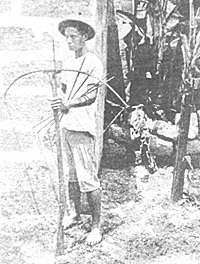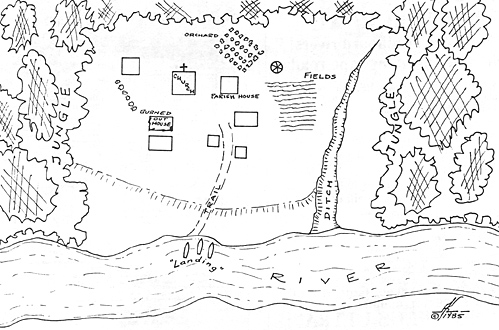 Many people do not realize that America also had its 'colonial' wars, not only
against the Indians and during the Boxer Rebellion, but in the Philippines from
1889-1935. The American military fought a variety of groups and tribes such as
the Moros, Pulaian and even Head Hunters during this period
Many people do not realize that America also had its 'colonial' wars, not only
against the Indians and during the Boxer Rebellion, but in the Philippines from
1889-1935. The American military fought a variety of groups and tribes such as
the Moros, Pulaian and even Head Hunters during this period
The battle described below was fought using THE SWORD AND THE FLAME rules by myself and several friends. For the Americans we used the British charts and the Dervish charts for the Pulajan. As figures for this period are impossible to find we used Civil War (Union) figures for the Americans and Dervish figures for the Pulajans.*
The battle is based upon a true skirmish foughtcluringthe Pulajan Uprising in Samarlsland, 1902-1911. Religious fanatics led by Papa (or Pope) Pablo were intent upon destroying the coastal village people and the American forces there to protect them. Using human mass attacks with bolos and various other weapons they were highly successful and devastated much of the island until defeated in 1911.
What follows is a typical action during a period that saw heavy and bloody fighting. This whole period has also many possible campaign opportunities.
*ED. NOTE: Figures for this period are now available from FRONTIER MINIATURES, 7343 Branding Iron, Canutillo, TX 79835.
THE BATTLE OF SAN RAMON
1st and 2nd Platoons, 18th US Infantry, 20 men and 1 officer each, were ordered to occupy the village of San Ramonto protect the residents from the fanatic Pulajans led by Papa Pablo. Leaving the coast they rowed up the river in three boats arriving at San Ramon two days later to find the village deserted.
Philippino Rebel With Crossbow From A Spanish Magazine Printed In 1900. Courtesy Of Jose Neira.
Believing that the Pulajans had already destroyed the village and carried off the inhabitants, Lt. Stevens, 1st Platoon and expedition commander, allowed his men to relax and cook their noon day meal in the center of the deserted village without placing any sentries. Unknown to the good lieutenant San Ramon was being surrounded by Papa Pablo and 500 of his best warriors.
The Pulajans were split up into 5 bands of 100 men each. 4 units were armed with the traditional two bolos, long sharp swords carried in both hands. The last unit was armed with rifles.
The first time that Lt. Stevens knew there was something amiss was when the Pulajans, in the blood red uniforms and red capes, burst from the surrounding jungles east and west of San Ramon screaming, "Tad-Tad-Tad" (chop, chop, chop to pieces!). Realizing that his men were cut off from the boats, Lt. Stevens ordered his men to fall back to the abandoned church building and prepare a defense. Reaching the church only moments before the Palajans, fierce hand-to-hand combat broke out before the Pulajans were forced to retreat, shaken by the melee and accurate fire from the Americans armed by Krag rifles.
Papa Pablo soon rallied his forces and the church was rushed a second time. Once again the attack was defeated with heavy losses to the Pulajans. After a third assault was thrown back 2 of the bolo units had been routed, the rifle unit had retreated toa burned out house, and it appeared that the Americans, with only minor losses, were safe in their fortified church.
However, Papa Pablo was not a man to be taken lightly. Faking a fourth assault, one of the two remaining bolo units raced into the adjacent parish house. Safely behind its walls and covered by the rifle unit in the burned out house, the Pulajans began to throw bundles of straw and hemp soaked in kerosene onto the roof of the church in an effort to set the structure on fire.
Aware of this new danger, Lt. Stevens, with 1st Platoon, charged the parish house hoping to force the Pulajans out. Under heavy rifle fire and stiff resistance, the 1st Platoon was forced to retreat from the parish house having sustained losses of 3 dead and 4 wounded. Since Lt. Stevens was one of those killed in the assault, Lt. Henry, 2nd Platoon commander, now took command.
The church roof was by this time ablaze and Henry had no choice but to try to fight his way back to the boats. Racing from the church, the Americans were rushed by the remaining bolo units, the unit from the parish house having left the building knowing the Americans would be forced out of the church because of the flames.
Even more damaging to the Americans' retreat was the surprisingly accurate fire from the Pulajan rifle unit. Lt. Henry was among those severely wounded and 2nd Platoon's Sergeant Jenkins was killed.
Confronted by the bolo carrying Pulajans, 1st Platoon failed to close and fell back shaken. 2nd Platoon then took the full brunt of the attack. Fighting valiantly but heavily outnumbered, they were nearly annihilated. The survivors, routed, ran for their lives only to be cut down from behind by the pursuing Pulajans still yelling, "Tad-Tad-Tad!"
While 2nd Platoon met its end, 1st Platoon, roughly a dozen men left, under fire from the Pulajan rifle unit, were rallied by Sergeant Hoffman and retreated to the deep ditch to the east of the village.
Having finished off Lt. Henry and the 2nd Platoon, the Pulajans, flushed with victory, turned to rush the ditch. Again in a strong defensive position the Americans took heart and poured a devastating fire into the charging Pulajans at point blank range causing 1 bolo unit to rout and the other to become shaken.
With no desire to sacrifice further men in order to destroy the remnants of the American force, Papa Pablo, content with his victory, ordered a retreat. Sergeant Hoffman and the survivors of 1st Platoon made their way into the jungle and after a week of near starvation and terrible hardships reached the coast. They had learned a hard lesson of being careless in Pulajan territory.
The above is ony one example of the fierce jungle fighting experienced by US forces fighting in the Philippines. Whether fighting Pulajans, Moros, or other hostile groups in jungle skirmishes, village defenses or direct assaults on native fortresses, this era is rich in wargaming potential. Hopefully interest and figures will soon match the possibilities for skirmishes, battles and campaigns which exist here.
Good sources for information are: Russell Roth, Muddy Glory, America's Indain Wars in the Philippines 1898-1935; Joseph L. Schott, The Ordeal of Samar, Vic Hurly, Jungle Patrol, and Col. Ernest R. Dupuy, The Little Wars of the United States.
Map

Back to Table of Contents -- Courier #56
To Courier List of Issues
To MagWeb Master Magazine List
© Copyright 1991 by The Courier Publishing Company.
This article appears in MagWeb (Magazine Web) on the Internet World Wide Web.
Other articles from military history and related magazines are available at http://www.magweb.com